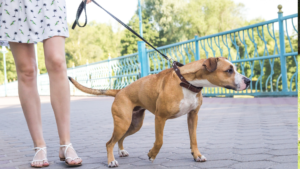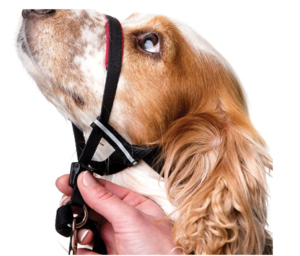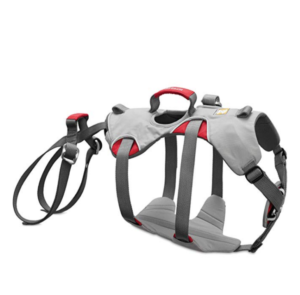Training your dog well can be challenging, but having the right Harness for Dog Training will make it immensely more relaxed and less frustrating.
We’ve already talked about the best treats for training (spoiler alert: the smellier, the better). The type of collar or harness for dog training also warrant careful consideration. We’ll help you out by covering some of the best picks here!
The good news is that you don’t have to spend hours reading product reviews and speaking to salespeople.
Instead, you can check out the top collars and harnesses for training your dog. This is recommended by some of the best animal behavior consultants in the country.
There’s no denying that they know their stuff, so any of their picks are sure to get you off to a good start.
Features to Look for in the Best Collars and Harness for Dog Training
Since we recommend using relationship-based training, we believe that you can do excellent dog training with any comfortable collar or harness.
No equipment is foolproof and failsafe. So we recommend using collars or harnesses as a stepping stone while you train your dog. While I’ll never stop using Barley’s collar and harness entirely. I don’t want to rely on a fancy contraption to keep him under control!
Still, when you’re starting out and just beginning to train your dog, having equipment that is safe, comfortable. And provides you with adequate control over your dog can make the training process much smoother.
What To Look For In Your Training Collar or Harness:
Comfort For Your Dog It’s much harder to learn when you’re afraid, in pain, or just uncomfortable. That means that one of the biggest things to look for in your best dog training collar or harness is comfort.
The type of collar or harness you enlist may vary depending on the breed of your dog. Most short-nosed breeds like pugs and boxers should always be walked on a harness. Since their breathing is already made difficult by a shortened nose. Collars can further exacerbate breathing issues.
Meanwhile, narrow-headed dogs like greyhounds and collies are best served by a martingale-type collar or harness.
All dogs should have freedom of movement in their shoulders. Meaning harnesses that have straps across their chest or shoulders are often a no-go. Avoid tackles that rub in your dog’s armpits or across their breasts.
Adjustability and personalization are critical here.
Many of our top picks are highly customizable, ensuring that you can get a perfect fit for your English bulldog, whippet, and cane Corso!
Most modern dog trainers, veterinary behaviorists, and animal behavior consultants strongly recommend staying far away from training contraptions. That can cause pain or discomfort for dogs, such as choke, prong, or e-collars.
They especially discourage these collars for beginner trainers and/or as the first line of defense for training your dog.

Ease Of Use For You (The Owner)If I’ve learned one thing in my years of working with dog owners. It’s that training has to work for both the dog and the owner.
If you hate putting on your pup’s harness, you’re likely to either skip the harness or the walk. It’s best to try on a harness before buying it to confirm that it works for your dog. And that you feel confident getting it on and off your pup quickly.
The same goes for choosing a leash – get a reliable dog leash that’s comfortable for you and provides all the features you need.
- Excellent Fit
A high collar or harness is only great if it fits your dog correctly.
Be sure to measure your dog before ordering a harness online. Check out Dr. Fosters and Smith’s excellent guide to measuring for a collar or harness here.
Keep in mind that different harnesses require different measurements depending on how they sit on your dog. So check the specific product first!
It can be a pain to pull out the measuring tape, but it’s worth it to avoid hot spots or escape if the fit is off. It’s also a good idea to check out breed-specific sites and reviews of harnesses since dogs come in so many shapes and sizes. If you’re really concerned about fit, going into a store is your best bet to get that perfect fit.
Many dogs are easy to fit for harnesses. Labs, cattle dogs, and other popular mid-sized to large breeds are a piece of cake. The trouble comes when your dog is one of the more “extreme” body shapes. Like sighthounds, mastiffs, or very stocky breeds. Take extra care with the fit if your dog falls into one of these categories.
- Safety
While comfort and proper sizing are a big part of safety, there are other added safety factors. You’ll want to consider when harnessing or collar shopping.
A few of the highlights
- Increased Visibility. I love dog training harnesses and collars that have reflective or glow-in-the-dark features. These help keep your pup safe during low-light walks, even if you’re on a sidewalk or bike path. Cyclists, walkers, and other dog walkers can see your dog more efficiently using these features, which keeps everyone safe and happy.
You can just purchase a light for your dog’s collar or harness if you can’t find a harness or collar with built-in visibility features. My personal favorite is the MTZRFLL 9Pcs Dog Pet Lights for Collars. Barley’s changes color every few seconds, making it extra-easy to see!
- Quick-release. Having a quick release option is really valuable to ensure that it’s easy to remove your dog’s collar quickly if your dog gets caught on a bush. A crate, or another dog. While I’ve never seen it personally, I’ve heard of tragedy when collars get tangled during play or rest. Almost any snap-type collar is considered quick release, while a belt-buckle-style collar is not.
- Sturdiness. If your dog is reactive, doesn’t come when called, or could decide to run away from a scary trigger, you don’t want a collar that could break or slip off. This is why I’d never recommended a collar or harness that stays on using something flimsy like velcro for a dog over 25 pounds!
It may seem confusing to say that you want to look for a sturdy collar that also has a quick release. What you want is extreme durability and sturdiness. A reliable emergency parachute in case things go wrong!
Belt buckle-type collars are less likely to break when your dog lunges or tries to pull away. But they’re also nearly impossible to get off your pup in a pinch. Weigh the options carefully when selecting which collar to buy and when to take your dog’s collar off.
Do I Want a Collar or a Harness for Training My Dog?
Many trainers say that collars are for decorative purposes and are a great way to hold identification tags. These trainers prefer to train dogs on a harness – and I agree! For many owners, harnesses will be the way to go.
Other excellent trainers firmly believe that it’s not the equipment that matters, but the training done between the dog and owner. Either way, most of the best dog equipment for training falls into the harness bucket rather than the collar category.
In general, I prefer to work with dogs using a back-clip Y shaped harness while still in training.
The benefits of a back-clip Y shaped harness include:
- It doesn’t reduce oxygen availability for your dog. Any neck collar that makes your dog gasp is not the right choice for training! As mentioned, this is especially important for short-nosed breeds, but it is generally a good rule for all dogs.
It doesn’t press on your dog’s thyroid glands. Pressure on thyroid glands on dogs that pull hard on neck collars or are given many leash corrections has been linked to thyroid issues. It considers that thyroid issues relate closely to aggression.
- It’s vital to teach your dog not to pull and to avoid leash corrections if you want to reduce your dog’s chance of developing thyroid issues and (potentially) aggression!
- It doesn’t interfere with your dog’s range of motion. Many front-clip harnesses have a strap that goes across the front of a dog’s chest or the top of her shoulders. These straps can shorten or change your dog’s gait, leading to joint issues down the line. They can definitely be valuable for pullers but aren’t the right choice for all dogs – especially if your dog doesn’t have a yanking issue. Read more about the pros and cons of front-clip harnesses here at Whole Dog Journal.
- Less leash-tangling. Many of my clients report that their pups get tangled in the leashless. It happens when using a back-clip harness when compared to a front-clip harness or collar.
On the other hand, one of the most significant downsides of a back-clipped Y shaped harness is that it allows your dog to really pull hard if they want. That’s where some of our other recommendations come in handy!
It’s best in the long-term to teach your dog not to pull than relying on equipment and contraptions to reduce dog strength.
Still, when you’re starting off, it can be handy to have a harness that prevents pulling – especially if you’re dealing with an energetic pooch!
A Dog Trainer’s Guide to the Best Collars & Harnesses for Dog Training
Below, we’ve picked out our favorite collars and harnesses to help you control your dog. We’ve also selected our ideal collars and harnesses for dog training if your dog does or doesn’t pull!
The ideal situation is to teach your dog to walk politely on a leash using treats, toys, and praise rather than using mechanical advantages from fancy collars or harnesses to control your dog. But we’ve all got to learn how to walk before we run! These are the best tools to use when you’re still working on the basics with Sissi

The Halti Optifit is one of the most well-known and popular brands of head halters around. While head halters can be a bit tricky to introduce properly to your pup, they’re hard to beat as far as the combination of safety and control. Consider purchasing a head halter for your dog if your dog is reactive, energetic, and/or a significant puller.
Head halters give you more control over your dog’s movement and gaze because of the leash clips to her muzzle.
It’s crucial to avoid jerking on a head halter since you could accidentally tweak your dog’s neck. It’s also vital to ensure that you use a backup leash since head halters aren’t as secure as a harness or neck collar. This can lead to a lot of leashes to keep track of!
What We Love: The Halti Optifit has reflective cheek straps. It’s also the most customizable head halter we can find on the market, making it the go-to for anything from whippets to mastiffs!
The Downsides: Head halters are strange and uncomfortable at first for most dogs, so be sure that you take the time to properly teach your pup to be comfy wearing this contraption! It can be a bit tricky to fit correctly, so get help if you need it. You also can’t leave the Halti Optifit on when you’re home, so you’ve got to remember to put it on and take it off again when you re-enter your house.
The Freedom Harness

I’m not generally the hugest fan of no-pull harnesses because of potential orthopedic issues, but the Freedom Harness is different.
Rather than having a strap that cuts across your dog’s shoulders, shortening her gait, the Freedom Harness is shaped by my beloved Y-shape design.
No-pull and front-clip harnesses are an excellent way to feel in control of your walks without hurting your pup.
They’re not really a training tool since they won’t teach your dog not to pull. Instead, I think of these harnesses as ways to enjoy your walk and feel comfortable while you work on training your pup to walk politely!
What We Love: This harness includes two points of connection, allowing you to be extra-secure or switch back and forth from front-clip to back-clip harness options. It also stands alone in the no-pull harness market as a harness that doesn’t restrict your dog’s movement. It comes in a variety of pretty colors, so you can ensure that your pup’s training proceeds in style.
The Downsides: Front-clip harnesses aren’t always intuitive to put on, and the Freedom Harness is no exception. Be sure to double-check that you’ve got the Freedom Harness on correctly at first.
As a front-clip harness, the Freedom Harness works by pulling your dog’s weight to the side. This reduces pulling strength but can be easily tangled and causes your dog to walk a bit diagonally if she keeps pulling. You probably want to remove your harness after a walk, too.
Houdini Hound Pick #2: Ruffwear Webmaster Harness

Let’s face it. Some dogs are just Houdinis. But many Houdini hounds have met their match with the Ruffwear Webmaster Harness.
Rather than the traditional single strap behind your dog’s front legs, the WebMaster has two straps. This makes it nearly impossible to wiggle out of.
What We Love: Ruffwear really knows their stuff when it comes to quality – their dog gear often tends to be the best or near the top on all canine equipment lists. This continues to be true for the WebMaster harness.
The WebMaster is easily one of the safest and sturdiest harnesses on the market. It’s reflective, hard to escape from, unlikely to break, and comes in a variety of colors. Definitely, a hard one to beat!
The Downsides: Some dogs hate how the WebMaster slips over their head. If your dog is a bit uncomfortable with handling or new things near her face, the WebMaster can be pretty scary. Old and inflexible dogs might struggle to get their legs through the loops since you have to help manipulate their limbs into the correct position.
Best for Tiny Dogs
Petite Pooch Pick: The Wrap N Go Harness

I said I don’t love harnesses with velcro closure, but the Wrap N Go Harness is the exception!
Its velcro closure is ultra-strong. One trainer I spoke to said it took two hands to remove this collar off of her poodle!
The Wrap N Go is easy to use and comes in a variety of colors. If you’ve got a tiny dog who needs an extra-comfy harness, this is your answer.
What We Love: When you want comfort and safety for your tiny pup, this is your answer. The Wrap N Go has a velcro closure at both the neck and the chest, ensuring that small dogs can’t slip out easily.
The Downsides: This harness doesn’t have many points of adjustment, instead of relying on comfy stretchy fabric to fit your pup. That might make it more challenging for a super-skinny Italian greyhound or a chunky pug than some of the other options on the market. Some owners also had a hard time keeping their dog’s long hair out of the velcro. Ouch!
